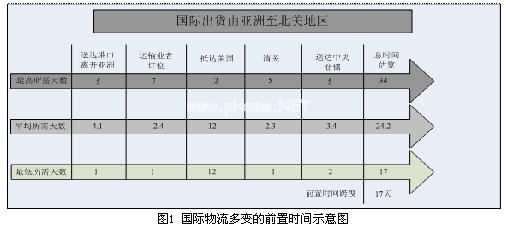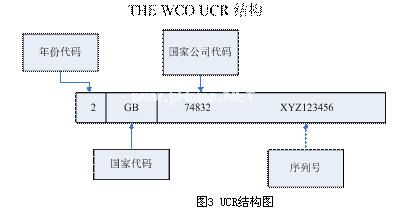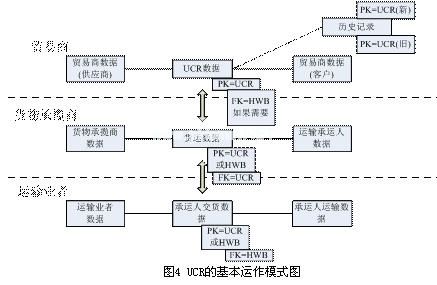Research on global supply chain transparency using RFID and UCR
Abstract: This paper analyzes the problems in the global supply chain, and uses RFID technology to wirelessly locate the goods in transit and record and store the goods information, and uses UCR technology to assign a unique set of identification numbers to the goods, so that the goods and the entire The transportation process is closely linked, which makes it easy for suppliers and carriers to identify and track the goods, ensure the safety of the goods during transportation and handover, and create a transparent and convenient global supply chain.
1 Introduction
The supply chain is based on the core enterprise, through the control of information flow, logistics and capital flow, starting from the purchase of raw materials, making intermediate products and final products, and finally the sales network will deliver the products to consumers. , Distributors, retailers, and end users to form a whole functional network chain structure model. The spirit of supply chain and logistics management is optimized inventory management, that is, under the lowest cost and risk, to effectively meet customer needs and achieve corporate goals.
Supply chain and logistics management at the strategic level is to think about the overall operation mode and global layout, such as changing the production mode to post-order production (BTO, Build to Order), and using the supplier management inventory set up on the client's warehouse ( VMI (Vendor Managed Inventory) mode; at the operational level, it can be achieved by supply chain planning (SCP, Supply Chain Planning) that belongs to the inventory management perspective and supply chain execution (SCE, Supply Chain ExecuTIon) that belongs to the transportation management perspective. Optimization of supply chain and logistics decisions. The parallel use of these operating modes greatly reduces the possible inventory of planned production sites, thereby improving the efficiency of supply chain operations.
However, when faced with a transnational or even global logistics environment, pure planning and planning inventory management is facing a severe test. Multinational transportation companies must face the changes and risks that may arise in the process of freight contracting, customs, sea and air transportation, such as high inventory lead time, shortage of goods delivered on time, and possible excess inventory. As shown in Figure 1, suppose that considering the process and time that goods may be shipped from Asia to the North American market, the maximum required lead time and the minimum required lead time for the entire logistics may be 17 days different. In this case, you may have to hold more than two weeks of inventory to cope with possible changes. To solve the above problems, global supply chain transparency at the level of transportation management is a possible solution.

2 Global supply chain status and existing problems
The so-called transparency of the global supply chain is to establish a system electronically, connecting the global sea, land and air transportation, customs clearance, warehousing and other transportation processes from order to product delivery to the customer side, in order to understand the status of product transportation in real time, which can effectively Take control of the entire logistics process and actively manage it, reduce the number of days in the logistics process and the loss of delayed arrival, and avoid the need and cost of urgent delivery. Global supply chain transparency can be subdivided into two parts: one is the active management mechanism; the other is to update the cargo status and various document information in real time, including purchase orders, sales orders, warehouse receipts, booking orders, delivery orders, etc. .
The active management mechanism is an active management mechanism that cooperates with inventory management planning and handles exceptional situations. For example, the planned time and tolerance range set for each transportation stage in advance, and when the actual transportation / shipping time exceeds the tolerance range, an emergency response and relevant necessary measures are taken, such as urgent outgoing and outgoing goods, transfer of goods, etc. Relying on the operation of the active management mechanism, the transportation information obtained in real time can be implemented to the management level, and the inventory management can be effectively carried out.
The purpose of supply chain management is how to obtain products at the lowest price and the fastest speed at any time and any place. In order to meet this demand, companies have to adjust the logistics operation process driven by customer service, and implement the supply chain operation mechanism of collaborative business with business partners (suppliers, customers, etc.).
Nowadays, international trade continues to expand and expand, and there are many participants in the transportation of goods, including sea, land, air and customs agents, which complicates the transportation of goods, the trade procedures become cumbersome, and it is not convenient for goods inspection. Safety has a certain impact.
In international trade, some countries ’cargo owners and airlines still use fax, electronic information, or written customs documents. This affects the speed of customs clearance of goods, greatly reducing the efficiency of goods transportation and increasing the cost of transportation. At the same time, there are also some hidden safety hazards, especially the transmission of documents in written form, which involves personnel operation errors and safety issues in the process of transferring documents halfway. Some advanced countries have developed electronic customs clearance systems, but the formats are different, such as: original forms, UN / CEFACT information, etc. If the whereabouts of the goods are unknown, due to the different form codes and different formats of the countries, the tracking of the goods is not easy, which brings certain difficulties to the customs audit and greatly reduces the security.
3 Technical key to transparency of global supply chain
Radio frequency identification technology (Radio Frequency IdenTIficaTIon) is a kind of automatic identification technology, that is, non-contact two-way data communication through wireless radio frequency to identify the target. Compared with traditional identification methods, RFID technology can complete information input and processing without direct contact, without optical visualization, and without human intervention, and the operation is convenient and fast. It can be widely used in production, logistics, transportation, transportation, medical treatment, anti-counterfeiting, tracking, equipment and asset management and other application fields that need to collect and process data, and is considered to be a future replacement for bar codes.
The development of RFID technology can be traced back to the time of World War II, when it was used to identify enemy and foe in air combat operations. Historically, RFID is not a new technology. From the perspective of classification, because of years of development, RFID technology below 13.56MHz has been relatively mature. At present, the industry is most concerned about the RFID technology located in the middle and high frequency bands, especially the long-range RFID development from 860MHz to 960MHz (UHF band) Fast; while the 2.45GHz and 5.8GHz frequency bands are crowded, their related research and applications are still in the exploration stage.
The basic RFID system is composed of three parts:
Electronic tags: composed of coupling elements and chips, each tag has a unique electronic code, attached to the object to identify the target object;
Reader: With the function of reading and writing tag information, it can be designed as handheld or fixed. It can realize data read-write, display and processing functions alone, or it can be combined with a computer or other systems to complete the operation of the radio frequency tag.
Line: Pass the RF signal before the tag and reader. Some systems also connect to external computers through the RS232 or RS485 interface of the reader to exchange data.
The composition structure of the radio frequency identification system is shown in Figure 2. Among them, the spatial (non-contact) coupling of the RF signal is realized between the RF tag and the reader through the coupling element. In the coupling channel, according to the timing relationship, energy transfer and data exchange are realized.

RFID technology uses wireless radio frequency to carry out non-contact two-way data transmission between the reader and the radio frequency card to achieve the purpose of target identification and data exchange. Compared with traditional barcodes, magnetic cards and IC cards, radio frequency identification has the characteristics of non-contact, fast reading and writing, no wear, no environmental impact, long life order, easy to use, etc. and has anti-collision function, can handle multiple electronic label.
At present, different products that meet different standards within the working frequency range of RFID products are defined, and RFID products in different frequency bands will have different characteristics and different typical applications. Generally, the low frequency (<135MHz) is mainly used in automobile anti-theft systems, animal husbandry management and other fields. High frequency (13.56MHz) is mainly used in the fields of library management, anti-counterfeiting of medicines, all-in-one cards and other fields. UHF (860MHz ~ 960MHz) is mainly used in supply chain management, highway toll collection and other fields.
4 Standardization of information
The liberalization of WTO entry promotes the emergence and development of markets and regional free trade circles, accelerating the pace of globalization. In order to ensure that the information chain is compatible with both customs and customs, it is necessary to develop a method that meets global standards. It must replace the existing number in the international supply chain and serve as the entry key for common data. Cargo dealers, couriers, freight contractors and importers to physical logistics.
UCR (The Unique Consignment Reference Number) is the unique tracking number of the goods. When the importer and the exporter formally sign a sales contract, the UCR number is first agreed, and the batch of goods is given a unique set of numbers that can distinguish its uniqueness. The number is barcoded It is affixed to the goods, no matter how many intermediaries or government agencies pass by on the way, this number has been closely integrated with the transportation process of the batch of goods until the foreign importers complete the customs clearance procedures to receive the goods. In other words, UCR is a set of codes that connects the entire cargo sending end to the destination transport chain. The users involved include importers, exporters, intermediaries (such as banks, insurance companies, credit bureaus, transport companies, storage companies, goods Contractors, domestic customs brokers, etc., and relevant government agencies (such as customs, trade agencies, signing agencies, and quarantine agencies), etc., the customs is not a single-use unit.
UCR code is composed of 35 alphanumeric characters. As shown in Figure 3, the first character is used to identify the specific year of the decade, represented by the numbers 0-9. The following two characters represent the country code, in order to identify the country issued by UCR. The remaining 32 characters include a company identifier for the officially disclosed country and a continuous unique reference code for internal use by the issuer.
However, at present, only ISO15459-1 defines and describes UCR codes, and RFID-related organization EPCglobal is negotiating with WCO whether it can be integrated with SSCC (Serial Shipping Container Code) codes.

5 Realization of global supply chain transparency
The key to achieving transparency in the global supply chain is the standardization of information. Only standardized information can connect different freight forwarding, transportation and warehousing companies around the world. The unique tracking number of the goods is assigned to the unique set of numbers before the goods are transported. No matter how many intermediaries or government agencies pass through during the transportation, this number will be closely linked to the goods until the foreign importer completes the customs clearance process to receive Until the goods. In fact, UCR has realized the standardization of cargo information here, which is convenient for the transportation of cargo, and customs clearance has become very simple and fast. At the same time, the cargo can be tracked, and the security of the cargo is further guaranteed.

The basic operation mode of UCR is shown in the figure below. The commercial units included in the transportation of goods are: traders, cargo contractors, transport operators and customs. The application of UCR can also be divided into single delivery, assembling delivery of goods and delivery of goods. Single delivery is to assign a UCR number to a whole batch of goods and transport the goods to the destination through a mode of transportation. Consolidated delivery of goods refers to the collection of goods from different shippers to the same place, and then assembled into batches or boxes and transported by one mode of transportation. The separate shipment of goods means that the whole batch of goods is given the same UCR number, and the different goods are used to transport the goods to different destinations.
Usually the same UCR number is used to transport the goods from the starting point to the destination, but there are exceptions in some cases, such as the resale of goods, the UCR number will change, in this case, the history of the UCR number should be recorded, In order to track the goods.
RFID technology is a crucial technology to achieve transparency in the global supply chain. Unlike contact identification technology, RFID system transponders and readers can complete identification without contact. Compared with bar code technology, RFID technology has a farther identification distance, so it can be used in a wide range of occasions. With the maturity of large-scale integrated circuit technology, the volume of RFID systems has been greatly reduced, and has now entered the stage of practical use.
The RFID system provides a detailed and unique perspective of the supply chain by providing individual identification and storage and transportation history records for each product, achieving full tracking of the goods and transparency of the supply chain. The RFID system does not use a central computer to record the location of each pallet or product. It can clearly know the location, identity, storage and transportation history, destination, expiration date, and other useful information of the containers on the pallet or even individual products. The RFID system can provide such detailed data for the actual goods in the supply chain, and establish a physical connection between the goods and their complete identity, users can easily access these completely reliable goods information.

Figure 5 is a basic view of global supply chain transparency. UCR numbers and RFID tags are assigned to the goods when they are shipped out of the factory or for customs clearance. The EPC global network monitors and tracks the goods, making the whole process of goods transportation visible.
UCR is a tool to promote international trade security, and RFID technology is a weapon to make goods circulation transparent and convenient. The integration of the two can build a global safe and convenient international trade environment.
6 Conclusion
RFID technology is a transformative technology. Although it has only been used in the field of supply chain management in recent years, it has shown its role that cannot be underestimated, providing technical standards for the safe transportation of goods; and UCR for each piece of goods Provided a unique number, so that once the goods are lost in transit or shipped to the wrong destination, we can find the goods through UCR and ship them to the exact location to prevent the loss of the goods. The combination of these two technologies promotes the transparency and convenience of the global supply chain and provides a safe environment for future international trade.
Measurement data can be sent via PufangTech`s RS485 Wireless Modem for point to point or point to multi-point data communication with a range of 1km to 50km. It provides a transparent half duplex radio serial connection wirelessly operating in VHF/UHF frequency band.
The parameters of the wireless modems can be configured through the local serial port using Windows based software. The individual configuration parameters can be stored on PC for future use.
PufangTech wireless modem equipped with LEDs which enable the operator to see at a glance the status of the modem and its interfaces. The LEDs provide the operator with a quick visual check and if the modem is in normal operation, configuration or alarm status.
RS485 Wireless Modem is developed for remote supervision and control applications. Typical target applications such as slave stations of oil, gas and water pipelines, environmental monitoring, street light control, wastewater pumping stations and OEM applications.
RS485 Wireless Modem
RS485 Wireless Modem,RS485 Wireless Data Radio Modem,RS485 Wireless GSM Modem,RS485 Wireless Router Modem
Shenzhen PuFang Technology Co., Ltd. , https://www.hytelus.com